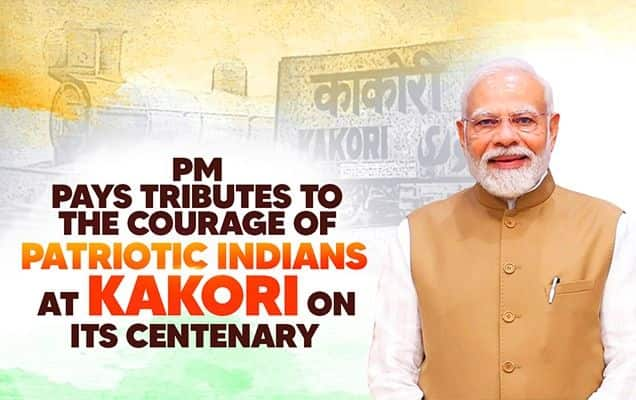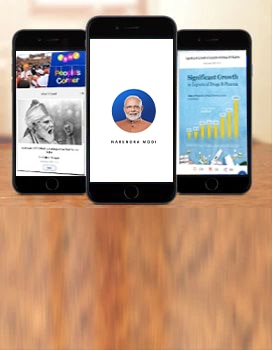The Hon’ble Speaker mam, my gratitude to you and all the respected members of the House on this occasion. We all feel proud to be a part of this august gathering in Parliament to commemorate the august kranti. Many of us remember the events unfolding of august 9 i.e. the august kranti. However even after years, such major events the memory of such major events are source of inspiration for the people. Remembering such important events gives a new boost to the life and strength to the nation. In the same way it is our duty to ensure that this message reaches out to our new generations. Every generation is responsible for bequeathing the legacy and the glorious history of their times generations, the atmospherics at that time, the sacrifices of our great men, the duty, the power, to the future generations.
When the August Kranti was commemorated in its 25th year and 50th year, it was celebrated by the people across the country. As we commemorate the 75th year of this event today, it indeed a matter of pride for us. There for I am grateful to the speaker mam for having provided this opportunity.
In the history of our freedom movement, the 9th August movement has been such an important, extensive and intense movement which even the Britishers could not imagine.
Mahatma Gandhi and all senior leaders were put behind the bars. This was the time when many new leaders came to the forefront - Lal Bahadur Shastri, Ram Manohar Lohia, Jaiprakash Narayan while many youngsters joined the movement to give it the desired momentum. Such movement in the history of our nation should be seen as a new inspiration, new energy, new resolve and the spirit of innovation among the people.
India became a free country in 1947. The period between 1857 to 1957 was a witness to different stages in our freedom movement as many people laid down their lives for the nation and there were several ups and downs. However, the movement in 1942 was in a way the final mass struggle that the fellow citizens were waiting for. The 1942 movement prepared the ground work for our independence. We may recall the freedom struggle movement in 1857 when every corner of the country was reverberating with the call for freedom. Mahatma Gandhi return from abroad, Lok Manya Tilak call for Poorna Swarajya (Total Self Governance) and “Swarajya is my birth right” represent the sentiments at that time. It was followed by Mahatma Gandhi Dandi march in 1930. Netaji Subhash Bose creating INA inspired the people while many youngsters like Veer Bhagat Singh, Sukhdev, Rajguru, Chandrashekhar Azad, Chapekar Bandhu, laid down their lives for the motherland. All these events provided the momentum for the freedom and it was a situation of ‘now or never’. If it’s not for today, it will never happen again; such was the mood of the people of the country. Thus, every person of this country was involved in this movement. It seemed that Rajaji's movement was being carried out through the elite class. However in 1942, the movement had spread to every region and every social class in the country. The guiding forces were the words of Gandhi ji. This was the movements where the slogan of ‘Quit India’ was on everyone’s lips. One of the most striking features of this movement was that the sentiments which appeared in the minds of the people were altogether different from Gandhi ji’s thoughts, contemplation and ethics. The key words of this great man were, ‘We shall do or die’. These words from Gandhi ji were unique for the nation. Gandhi had said, "From today onwards, everyone should consider himself as an independent woman or a man and should act accordingly. I'm not going to be content with anything less than complete independence. We will do or die". These were Bapu's words and Bapu also clarified that he had not left the path of non-violence. However the situation and the pressure was such that even Bapu, had to adapt to the people's emotions while assuming the leadership.
All sections of the society; the villages, the farmers, the labourers, the teachers, the students joined this movement with the slogan ‘Do or die’. Bapu even used to say that – ‘whosoever becomes martyr because of the violence perpetrated by the British, one should write this slogan on his body that he was a martyr of this freedom movement’. Bapu tried to take this movement to such a height and the result of that was that India was liberated from the slavery of the British. The country was desperate for that freedom, be it a leader or an ordinary Indian, there was no difference in the intensity of this feeling. I believe that when the country stands united and when there is a power of unity, when the goal is set, the target is set then the people can walk towards that direction. Within five-years i.e. between 1942 and 1947 Mother India became free. At that time Rambriksh Benipuri had written a book titled “Zanjire Aur Diware” and inthat book he wrote, "There is a wonderful atmosphere throughout the country. Every person became a leader and every crossroad became the office of ‘the Do or Die’ movement. The country put itself inside the oven of revolution. The flame of revolution was engulfing the country. Bombay showed the way. All means of transport were stopped. The Court proceedings were stalled. The news of the bravery of the people of India and the brutality of British government was reaching every corner. The public had well placed the Gandhian mantra of ‘Do or Die’.
This book provides the description of that time and shows the kind of atmosphere at that time. It is true that British colonialism began in India and also ended in India. It was not only the freedom of India; after 1942 the way this flame erupted against the colonial rule across the world, India’s freedom became a source of inspiration for colonies in Africa and Asia. The way this inspiration had spread to various parts of the world had become a cause of tribute to the masses of India. Any Indian can be proud of this and after that we saw that once India got its independence, gradually all these countries became free. This tells us that this was a good evidence of the determination of India. The lesson for us is that when we are determined to do something we gradually move towards the desired goal. Then it becomes the strength of the country and we take the country out of the crisis and the country can be prepared for the new goals. The history is the evidence of this fact. At that time, the poetry of the national poet, Sohan Lal Dwivedi, vividly described the power of Bapu and the time and movement . In his poem he had said-
चल पड़े कोटि पग उसी ओर
गड़ गई जिधर भी एक दृष्टि
गड़ गए कोटि दृग उसी ओर
This means that the path walked by Mahatma Gandhi was followed by millions of people and where Gandhiji's eyes were fixed, the eyes of millions were set upon the same thing. But today when we are in 2017 we cannot deny the fact that we do not have a Gandhi today. Today, the level of leadership that we had at that time does not exist but we have the strength of 1.25 Crore Indians. If we all try together it will not be a difficult task to fulfil the dreams of Gandhi and dreams of those freedom fighters. Today we have the opportunity in 2017 an enabling situation like that of 1942. The world is undergoing a crisis today. Just like in the year 1942 we became the source of inspiration for the world, similarly we can set an example for the world today as well and can be the source of inspiration. Today we are standing at this juncture, where we can avail the opportunity and how we should take upon this responsibility? I believe that we should take inspiration from these episodes of history. We should place the country above the party. Politics should be separated from this. If there are 1.25 crore people in the country, then we can easily progress by bringing the solutions to these problems successfully. How can anyone deny the fact that corruption can destroy the country like a termite - be it a political corruption, social corruption, or personal corruption. Let us not get into the controversy on who were involved and when. But today is a holy occasion and we should celebrate it with honesty and lead the country with honesty. This is the demand of the common man of the country. Poverty, malnutrition, illiteracy are the challenges in front of us. These challenges are not considered as challenges of the government but that of the country. There are grave questions in front of the poor and therefore we all have the responsibility of fulfilling this commitment for the country and to die for the country. For some of the issues we also had different sections of people in 1942. The people who believed in the violence were different. The ideals of Subhas Babu were different, but in 1942 everyone had said in a single voice: Quit India! This is our path under Gandhi's leadership.
Our upbringing and ideologies might be different. But today’s time demands that we take the opportunity to free the country from some issues, whether it is poverty, hunger or illiteracy. Why is that Mahatma Gandhi's dream of village Swaraj has been left behind? What is the reason that the people have left the villages and are staying in the cities? What was the issue concerning Gandhi ji regarding the village? Can we revive that dream? Can we do anything for the poor farmers, dalits, and the deprived class? These questions concern not a single individual or a group but all of us and the 1.25 crore people of the country. This is the time when the inspiration gives us the power to do something for the people and this inspiration should be utilised. We know that sometimes duties are neglected, authority is misused. This happens in both the political and social life. Unfortunately, some of these vices have entered into some of our lives and has turned it into a ‘way of life’. We don’t feel guilty if we jump the red light; this feeling of ‘I am breaking the law’ is never realised. If I spit somewhere, I do not feel that I am doing something wrong. Breaking rules has become our way of life. Even the smallest incidents are taking us towards violence. Whether it’s the mistake of the doctor or not, of the hospital or not, the relatives go and set the hospital on fire. They beat the doctor. If an accident takes place, we burn the car and kill the driver. As a law abiding citizen, we must be dutiful. Some vices have entered in our way of life, and we do not think that we are breaking the law and that is why it is the responsibility of the leadership and of the society to get rid of these faults that have crept into the society. Wake up to the duty of the society!
Toilets and cleanliness are not a matter of mockery. Those mother and sisters have to spend so much time waiting for the darkness to relieve. Thus, the mind-set of the society needs to be changed. It is necessary to educate the public to use the toilets. We have to be alive to this matter and these values can be instilled not by the law. We have to understand our duty. We should think of the mothers and sisters of our country who are under this burden.
The country should bear the burden of at least a class of people which includes women and sisters of this country. Their strengths can give us strength. In the freedom movements of Mahatma Gandhi many of these mothers and sisters used to lead and had made equal contribution during the freedom struggle. Even today, they have as much contribution to the nation. In order to take them forward, we should move forward with this duty.
It is true that from 1857 to 1942, we saw that the freedom movement had passed through different stages; there were ups and downs; different turning points, new leadership; sometimes it was violent, then non-violence. Sometimes there was an atmosphere of confrontation between the two streams, sometimes both the streams complemented each other. But we have witnessed this whole period from 1857 to 1942 which was incremental in a way. Gradually growing, slowly spreading, people were slowly connecting. But from Nineteen Forty Two to Nineteen Forty Seven, it was not an incremental change. There was an environment of disruption which forced the British to finish all the equations and give us freedom; to force them to go. From 1857 to 1942, everything was proceeding slowly, but between 1942 and 1947 this was not so.
If we look at the history of the society of the last 100, 200 years, the journey of development was incremental. Slowly the world was moving; gradually the world was changing itself. But in the last 30-40 years, there was a sudden change in the world. There was a sudden change in life. And technology played a greater role. No one can imagine what has changed in the world in these 30-40 years; 30-40 years ago we did not even notice this. We can feel a positive change with this disruption.
Just as we saw a quantum jump, I think 2017 and 2022, 75 years of Quit India and 75 years of independence respectively; within these five years, the same mood that existed between 1942 and 1947 shall prevail. In 2022, we will celebrate 75 years of independence, by that time we should fulfil the dreams of the heroes of the freedom struggle. We will carry forward our resolve and move forward. I believe that not only will our country progress, but due to the success of Forty two to Forty seven, many countries of the world have benefited, the ardour of freedom arose, the strength was re-gained. If in the span of 5 years from two thousand Seventeen to Two thousand Twenty Two we take this responsibility to carry India to that height in front of the world then this only is the quest for leadership. It will be a great service to the nation if the country comes together in this endeavour. I am confident that we can do a lot of work with consensus on certain issues.
We just saw the GST, and I repeatedly say that this is not my political statement, but my conviction. The success of GST is not the success of any government; the success of GST is not the success of any party. The success of GST is the result of the willpower of the people sitting in this House. Whether sitting here or anywhere, it goes to all the states; goes to the general merchant of the country; And because of that, it was possible. The country's political leadership has done such a great job because of its commitment. It is something unique to the world. GST is a big wonder for the world, if this was possible then more decisions can be easily taken in the future by sitting here. And as a representative of the 1.25 Crore people, with the resolution of 2022, I believe that we shall continue to bring those results.
Mahatma Gandhi had given the slogan of ‘do or die’; that was the formula of that time. Today, in 2017, if we take this resolution that how will India become in 2022, then we will get rid of corruption from the country. We will all get together the poor and give them their rights. Together we will give young people more opportunities of self-employment. Together we will end the problem of malnutrition from the country. We will all end and eliminate the hindrances that stop women from moving ahead. Together we will eradicate illiteracy from the country and will continue to do it. And there may be many issues, but we should keep the mantra ‘do or die’ in our minds. These resolutions are not of any party or of any government but of 1.25 crore people of the country. In these five years, from 2017 to 2022, on 75 th year of independence, we should fulfil the dreams of the freedom fighters. Today, on August Revolution Day, remembering those great men, remembering their sacrifices, penance, and seeking their blessings, let us all get together lead the country by agreeing on a few things – making the country free from all the problems for fulfilment of dreams, power, strength and goal. With this expectation, I once again express my gratitude to you Madam and pay my obeisant to the freedom fighters.














